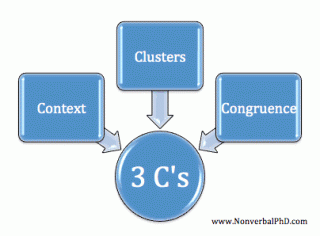Body Language
Is Nonverbal Communication a Numbers Game?
Is body language really over 90% of how we communicate?
Posted September 30, 2011 Reviewed by Abigail Fagan
Key points
- Many claim that 80 to 90 percent of communication is nonverbal.
- This statistical finding only applies to cases where one's verbal and nonverbal gestures are incongruent.
- It's hard to rely upon a single gesture or movement to define a person's state of mind or emotion.
If there were ever numbers associated with body language and nonverbal communication, they would be 55, 38, and 7. People often refer to these numbers as the standard for understanding nonverbal communication and expressing its importance—specifically over the words being spoken.
How often have you heard someone say over 80% (or even 90%) of communication is body language or nonverbal? Perhaps even you might have said it, but do you know where it originates from?
The numbers represent the percentages of importance that varying communication channels have. The belief is that 55% of communication is body language, 38% is the tone of voice, and 7% is the actual words spoken.
Is that true? Well, yes and no.
Firstly, the history behind this often quoted, and equally often misunderstood magic set of percentages is often unknown, which I think happens to be the main reason it is not fully understood. The famous (at least in nonverbal communication circles!) researcher Albert Mehrabian is responsible for this percentage breakdown detailing the importance of nonverbal communication channels compared to verbal channels. Actually, it was two research studies (Mehrabian & Wiener, 1967 and Mehrabian & Ferris, 1967) combined that resulted in the 55/38/7 formula.
The Mehrabian and Ferris study actually consists of a predecessor formula to the 55/38/7 formula: 60/40. The 60/40 formula they created represents the comparison of importance between facial (60%) and vocal (40%) components in regard to a person's attitude.
The problem with this, as with the general study of nonverbal communication, is that it is inaccurate to claim that a formula is absolute and applies to every situation.
What does Mehrabian think of this? He agrees.
The formula was created for a specific context—when the nonverbal channel and the verbal channel are incongruent (not matching). As he writes in his book Nonverbal Communication: "When there are inconsistencies between attitudes communicated verbally and posturally, the postural component should dominate in determining the total attitude that is inferred."
So should you still quote the 55/38/7 percentage at the next dinner party to show your nonverbal communication knowledge? Should you include an asterisk? Well, when I mention the 55/38/7 numbers, I clearly state that this applies to certain situations and, more importantly, should not be used as a deciding factor to try and understand the situation. A proper analysis needs to occur to fully grasp what the person's current emotions are at that moment.

One way of increasing your accuracy is by applying the 3 C's of Nonverbal Communication: context, clusters, and congruence. Context includes what environment the situation is taking place in, the history between the people, and other factors such as each person's role (for example, an interaction between a boss and employee).
Looking for nonverbal communication gestures in clusters prevents us from allowing a single gesture or movement to be definitive in determining a person's state of mind or emotion. Sure, crossing your arms at your chest can be a sign of being resistant and close-minded. However, if the person's shoulders are raised and their teeth are chattering, they might just be cold.
Finally, congruence we already discussed above in regards to the formula. Do the spoken words match the tone and body language? After someone falls, and they verbally state they are fine, however, their face is grimacing and their voice is shaky, you might want to probe a little deeper.
The 55/38/7 percentage and the 3 C's of Nonverbal Communication remind us that, when trying to understand others, a single gesture or comment does not necessarily mean something. Instead, these theories allow us to take note and observe more to get a better understanding of what is going on.
References
Mehrabian, A. (1972). Nonverbal Communication. New Brunswick: Aldine Transaction.


